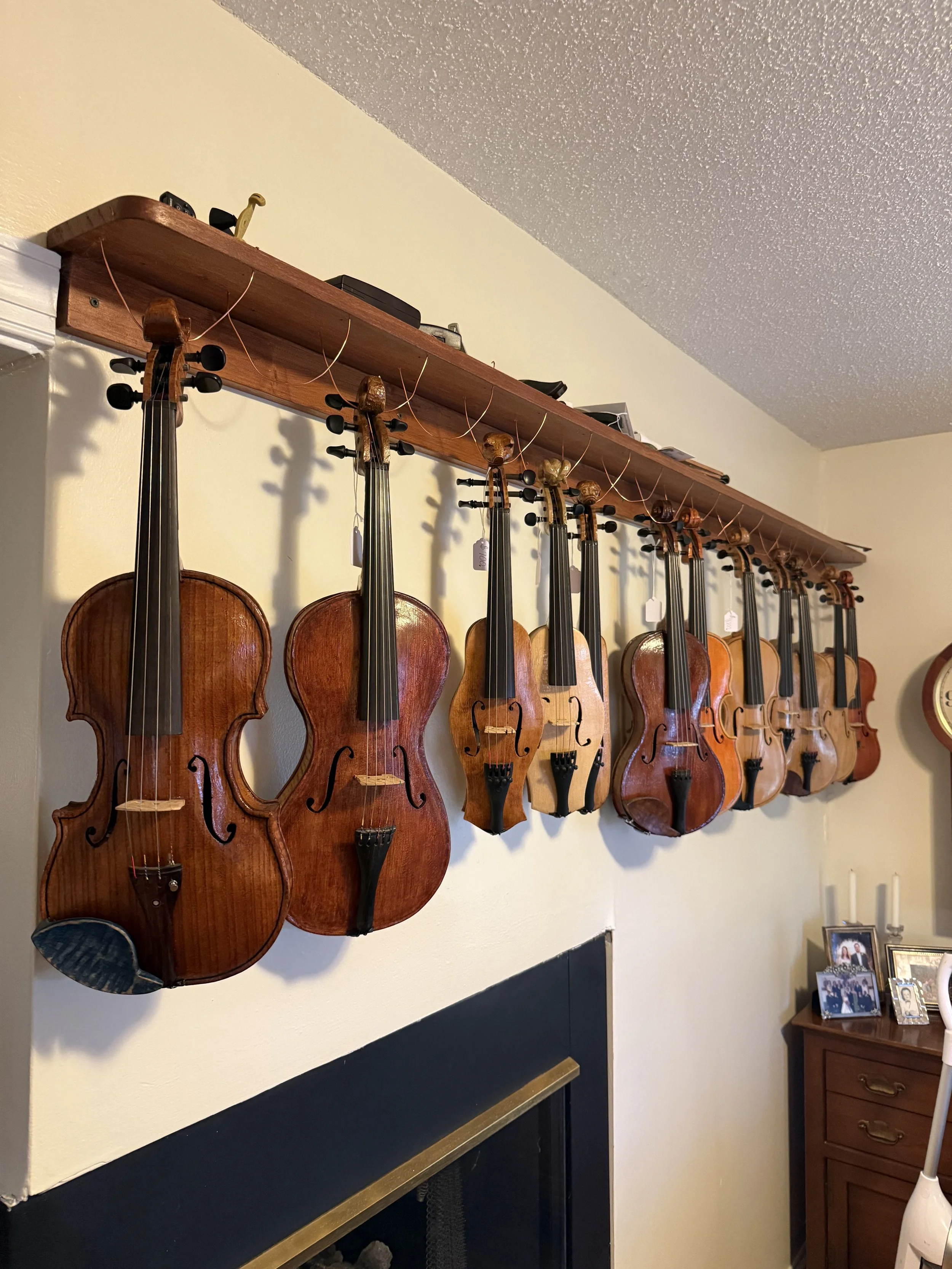Hands that Sing: The Master Craftsmanship of Fiddle-Maker Mike
Mike shows his finger planes, hidden in a small box on his workbench.
By: Lauren Anderson
Coming up to Mike Anderson’s backyard workshop in a corner of Louisburg I was met with a hedge of blueberry bushes over 6 feet tall, and Mike, locally known as Fiddle Maker Mike, basket in hand, gathering the day’s harvest. We walked through the zinnias and hydrangeas, to the edge of his shaded backyard and entered his wood shop.
“I wanted a challenge that would take me beyond my lifetime to figure out.” Mike told me as he sat down at the bench.
His journey started when he was just a boy and found a sharp knife that he used to carve up bars of soap. “I still have all my fingers.” he says with a grin. After moving around the country, he eventually found himself in Copper Hill, Virginia where he met the legendary self-taught instrument maker Arthur Conner.
"You have to have strong hands to do this," Mike recalls his mentor telling him decades ago, gripping his apprentice's palms to test their fortitude. "And you have to have a made-up mind. I have both.” he responded, and he does.
Among the unfinished violins, violas, and one large upright bass in various states of progression, Mike carefully picks up a nearly-complete violin top. Expertly in laid thin black lines, known as the purfling, outline a perfectly carved curly maple body. The wood shimmers under the light, a rippling pattern reflecting naturally occurring waves even without a stain applied.
Mike can chart the origin of each and every one of his violins, because he carefully selects every single tree that will become one of his instruments. To discover the tree that is destined to sing is an art in and of itself. He follows rules that sound more like superstition than carpentry: trees must grow on the northern side of mountains and be cut during a waning moon in the depth of winter His hands have felled Red Spruce at (precisely) 4,262 feet above sea level in northwest Virginia, where temperatures rarely dip below sixty degrees and growth rings cluster tight as closed fists. After harvesting, slabs sit in his workshop for several years to cure before he even begins the process of carving.
“Just like our voices are different, every voice of every instrument that I make is different. I can't replicate it.”
Mike’s finished violins are carefully hung in a room in his house in Louisburg.
His hands don't just work with tools—they are tools. In a tiny box are a set of finger planers of different sizes that act like extensions of his anatomy. The smallest, only centimeters wide, shapes the tightest curves where larger planers can't reach. After planing comes scraping with a razor, layer by microscopic layer, until the wood achieves the perfect measure of thickness.
But numbers only tell part of the story, as Mike shows me when he takes the violin and holds it carefully to his ear. He taps the carved spruce with his knuckles, head cocked, listening for that perfect "tap tone" that lets him know the violin is ready. It's a sound that floats rather than thumps, a voice waiting to be born.
Nowadays Mike now primarily showcases his work at the North Carolina State Fair's Village of Yesteryear, where his focus for the last 11 years has been to “educate, inform, and inspire.” Mike becomes a teacher, his hands demonstrating to wide-eyed children how wood shavings curl from finger planes. It's a moment of connection across generations with his seasoned hands guiding their eager ones in the ancient dance of craft.
Country music legend Charlie Daniels played one of Mike’s fiddles, though Mike speaks of this honor with characteristic understatement. What matters more to him are the hands that will hold his instruments decades from now, the fingers that will dance across strings, the arms that will draw bows, creating music from front porches to concert halls across the country.
Oddly enough, Mike himself is not a musician, but knows enough to “make a joyful noise” he says with a smile.
Now, after 25 years of making fiddles, Mike has chosen duck decoys as his next pursuit. Having recently picked up duck hunting, it’s no surprise that he says “why hunt over something plastic when you can create something with your own hands and wood.” If his decoys are anything like his instruments, he’s sure to become a master of those as well.
You can find Fiddle Maker Mike on Instagram at https://www.instagram.com/fiddlemakermike/.


